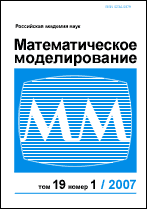|
Scenario modeling of the king crab stock collapse under expert control of annual catch
A. Y. Perevaryukha
St. Petersburg Federal Research Center of the Russian Academy of Sciences
Abstract:
For a number of actual situations, when the impact control strategy is determined on the basis of decisions of experts and stakeholders, it is advisable to carry out modeling in the form of a set of scenario computational experiments. The scenario approach allows us to compare the development of a situation given by formal conditions, simulating the logic of expert decisions and assessing the consequences for biological resources. For the structure of the scenario model, it is necessary to include conditions for changing the nature of the process, changing the behavior of the system, and defining a new control action. It is proposed to use a special form of representation of model time with continuous intervals and a hierarchy of events, which corresponds to the considered biological problem. A model with the property of multistability is formed on the basis of equations for the formation of adult generations. These equations change depending on the current stages of development and conditions of reproduction of crabs. The dynamics of the situation that led to the collapse of the Kamchatka crab stocks during irrational fishing is considered. The scenario develops from stages with sharp aperiodic fluctuations in the number, which are reflected in a transient chaotic regime. The discrete component of the trajectory of the model with hybrid time and formalized logic of expert fishery management describes the moment of the population collapse as the loss of the invariance property by the attractor, which is in contact with the boundary of its basin of attraction.
Keywords:
scenario modeling, nonlinear dynamics of ecosystems, collapse.
Received: 06.09.2021
Revised: 06.09.2021
Accepted: 21.02.2022
Citation:
A. Y. Perevaryukha, “Scenario modeling of the king crab stock collapse under expert control of annual catch”, Matem. Mod., 34:4 (2022), 23–42; Math. Models Comput. Simul., 14:6 (2022), 889–899
Linking options:
https://www.mathnet.ru/eng/mm4365 https://www.mathnet.ru/eng/mm/v34/i4/p23
|

|




 Contact us:
Contact us: Terms of Use
Terms of Use
 Registration to the website
Registration to the website Logotypes
Logotypes








 Citation in format
Citation in format 